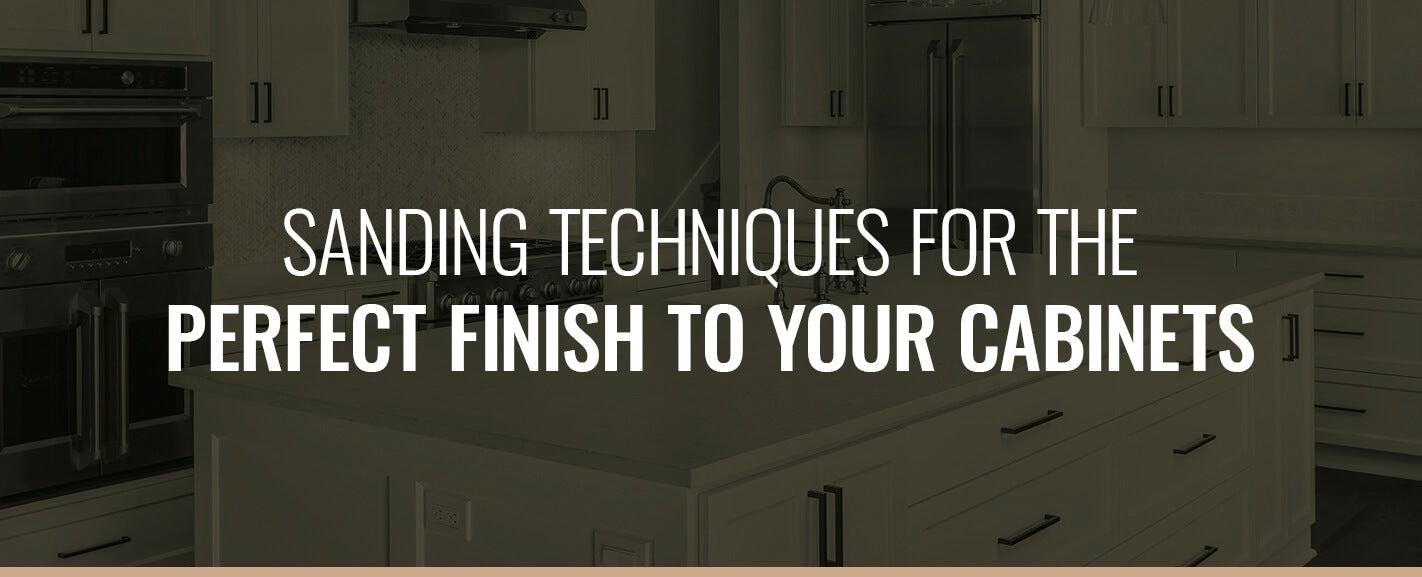
Experienced woodworkers and casual DIYers alike can spend a weekend refinishing their cabinet doors and breathing new life into a kitchen or bathroom. This project offers a lot of flexibility to make your cabinet doors into exactly what you want. It does require a little foresight, but we’ve put together a guide to the sanding techniques you’ll need to get the job done right. We’ll go over how to sand cabinet doors to prepare them for a top-tier finish, as well as some tips for finishing them.
You are watching: SANDING TECHNIQUES FOR THE PERFECT FINISH TO YOUR CABINETS
WHAT YOU’LL NEED TO SAND AND FINISH CABINET DOORS
Sanding cabinet doors is a fairly straightforward sanding project. The doors are easy to work with — unlike some large and bulky pieces — and most wooden cabinets can be sanded. As with every sanding project, you’ll want to get all of your materials together before you touch the sandpaper to the wood.
Before you start sanding, gather up the following items:
- Sander: Of course, you’ll need the sander itself. Your best bet is probably an orbital sander. You could hand sand your cabinet, but it will take a lot of elbow grease. You may even want to use both. An orbital sander can make quick work of the bulk of the cabinet door, but a sanding block or sanding sponge can help you cover any grooves or tight spots by hand.
- Sandpaper:You’ll also need to get your sandpaper. Grab some that fits your sander of choice. We’ll talk more about grits later, but some common grits for this job are 120, 180 and 220.
- Vacuum:A dust extraction vacuum is ideal for sucking away sawdust. The fine particles can jam up a household vacuum, so make sure you use one designated for sanding. You can even get vacuums that attach to orbital sanders and pull dust directly through holes in the sanding pad.
- Tack cloth:A tack cloth is a lightweight cloth with a sticky texture, used for picking up fine sawdust particles before finishing.
- Coverings:Depending on your workspace, you might want to place a drop cloth around where you’ll be sanding and finishing. It can make cleanup easier and protect your floors and furniture.
- Degreaser: You’ll want a basic degreaser to make sure the cabinets are free of any residue that would affect the result. You can use a typical dishwashing liquid, but a dedicated paint prep solution like trisodium phosphate (TSP) is good for tough grease.
- Finish materials: Whether you’re staining, painting or sealing, have your finish ready to go. If you’re using an oil-based finish, remember to get some mineral spirits for cleaning your brush or roller.
- Brushes, rollers or spray:Collect the tools you’ll be using to apply your finish. Check out the FAQ section to learn more about these options.
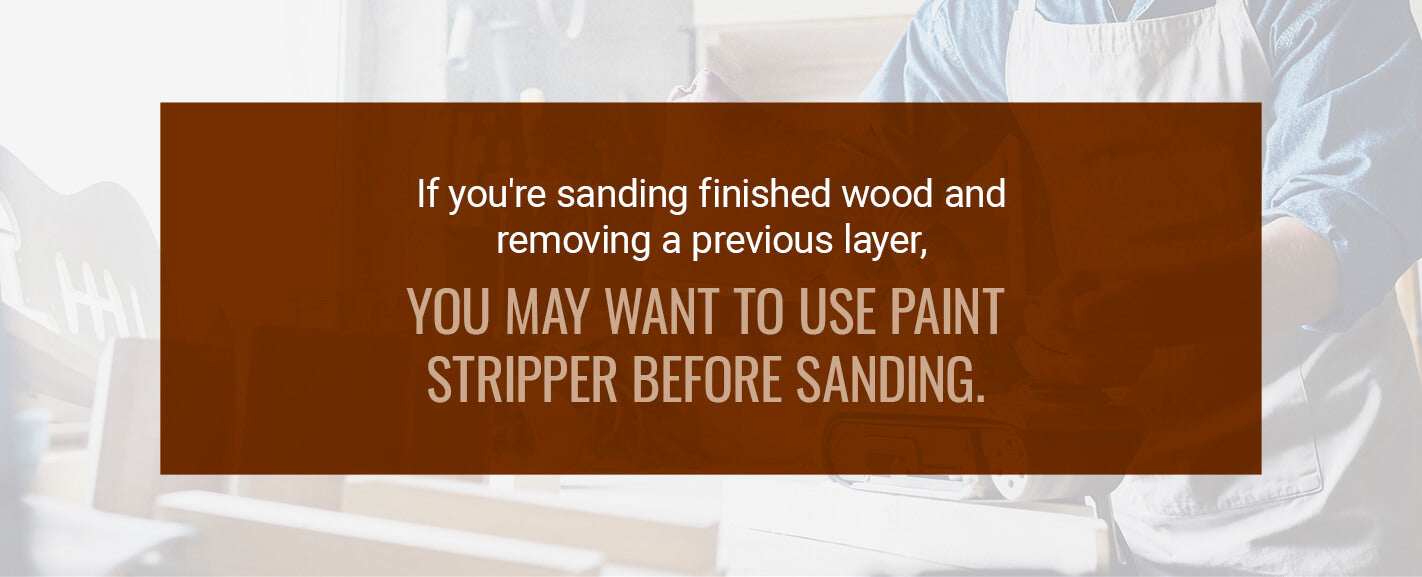
- Paint stripper and putty knife: If you’re sanding finished wood and removing a previous layer, you may want to use paint stripper before sanding. This substance will pull the existing material from the wood and cause it to clump up. With a putty knife, you can scrape off these clumps, leaving just the wood and a much easier sanding job.
- Wood-grain filler: Wood-grain filler works on open-grained woods, such as mahogany and oak, that have larger pores. Your finish can soak into these holes and create rougher surfaces. Wood-grain filler solves this issue and creates a smoother surface with fewer pores.
- Wood putty:Wood putty helps fill in nicks and dents to create a flat surface. Then, you can sand it and apply your finish over top.
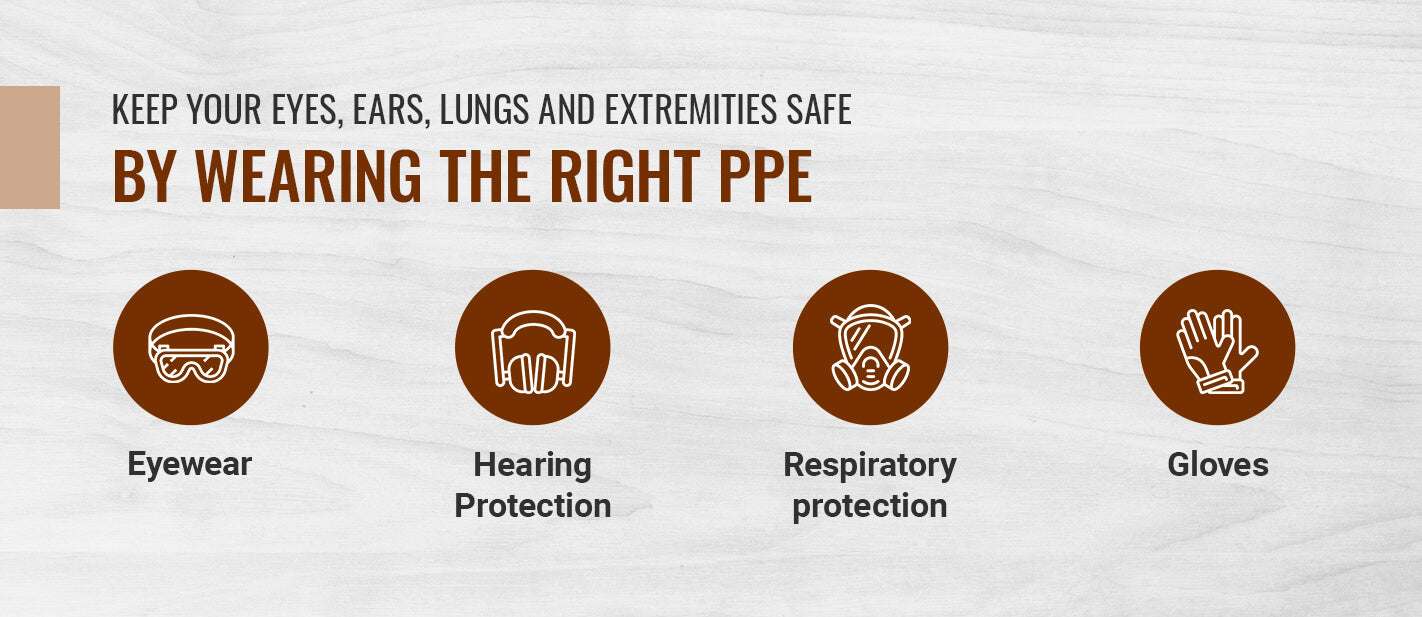
You’ll also need to consider personal protective equipment (PPE). Sanding releases tiny particles into the air, especially if you’re sanding off an old finish that could contain dangerous chemicals. Some finishes can also release hazardous chemicals. Keep your eyes, ears, lungs and extremities safe by wearing the right PPE:
- Eyewear: Safety goggles are great since they create a seal against dust, but glasses or face shields can also work.
- Hearing protection:The sound level that can cause hearing damage might be lower than you think, and many power tools exceed it. Grab some earmuffs or earplugs to keep your ears safe while sanding.
- Respiratory protection: If you’re just sanding small amounts of wood, a simple dust mask might be suitable, but once you add a larger quantity of dust or chemicals from paints, stains and varnish, you’ll need something stronger. In these cases, opt for a respirator. Be sure to understand the chemicals in your finish and use the right filters — particulate-level protection can block sawdust, and if your finish materials are relatively tame, that may be all you need. But if you’re working with organic vapors, such as paint thinner, lacquer or epoxy-based resin, you’ll need a filter with that designation.
- Gloves: A simple pair of gloves can keep you from sanding your own hand or getting chemicals on your skin. Even non-toxic paints and stains can be irritating and cause reactions. Plus, the dust in the air can dry out your skin. Wear some gloves to protect your hands.

Along with PPE, make sure your sanding and finishing environment is safe. For sanding, find a work area away from kids and pets, and ensure adequate ventilation, such as by opening a window or turning on a fan. If you can, try sanding outside, where you avoid building up particles in your home. When finishing, however, you want to avoid environments where dust, hair and dirt could land on your finished surface. Be careful to follow all safety recommendations, however, and keep harsh chemicals out of your living space.
HOW TO SAND CABINET DOORS
With your materials in hand, you can move on to the fun part. Follow these steps for sanding your cabinet doors:
1. Disassemble the cabinets:If you’re working with existing cabinet doors, take your doors off the cabinets and remove the hinges, handles and knobs. Take a little extra time here to draw out your cabinet configuration on a piece of paper. Give each door a number and write it both on the paper and on the door. Write it in the space where your hinge will go so you can cover it up later.
2. Strip the paint or degrease the surface:If you have a thick layer of paint or oil-based coating, slather on a layer of paint stripper. Wait for the amount of time directed and peel it up with your putty knife. If you’re just working with bare wood, grab your degreaser and wipe down the cabinet doors to remove any residue.
3. Fill in the grain or any holes: If you have a porous type of wood or dents and knots on the panel, apply wood-grain filler or your wood putty to keep everything smooth.
 4. Sand:Choose your grit and move your sander over the surface in smooth, even motions. For repainting jobs, start with 120-grit. If you won’t be adding any paint and will be using another kind of finish instead, such as a topcoat or stain, you can work your way to 180-grit, then 220-grit. If you want to sand a new door from the factory, you can go straight to 220-grit. Use a hand sander or sanding sponge to get in the crevices or curves. Remember to tap the sander occasionally to knock the dust off the sandpaper, and vacuum up your surface if sawdust starts to build up.
4. Sand:Choose your grit and move your sander over the surface in smooth, even motions. For repainting jobs, start with 120-grit. If you won’t be adding any paint and will be using another kind of finish instead, such as a topcoat or stain, you can work your way to 180-grit, then 220-grit. If you want to sand a new door from the factory, you can go straight to 220-grit. Use a hand sander or sanding sponge to get in the crevices or curves. Remember to tap the sander occasionally to knock the dust off the sandpaper, and vacuum up your surface if sawdust starts to build up.
Read more : How Much Do KitchenAid Mixers Weigh? (Size & Capacity)
5. Clean off your surface: Vacuum up the sawdust from the surface and wipe it down with a tack cloth for a clean, dust-free cabinet door. If your vacuum has a bristle attachment, use that to loosen up more dust. Unfold the tack cloth, wad it up and wipe down your surface. Unfold it and shake it out every so often, and get a new one if it loses its stickiness.
6. Apply your finish:Put your finish on the cabinet door. If you’re using paint, you’ll want to start with a primer and sand again between the primer and the paint. Use an extra-fine 220-grit and be sure to sand down any buildup, such as primer or paint that collected on the edges or in grooves. Follow the instructions for your finish and let it dry accordingly.
7. Assemble the cabinets:With everything finished, attach your hinges, knobs and handles and put the cabinet doors in place.
CABINET DOOR SANDING AND FINISHING FAQS
There are a few variables involved in this process. Here are some common questions and answers about sanding and finishing cabinet doors.
WHAT CABINET DOORS CAN BE SANDED?
Solid wood cabinets are the best candidates for sanding, but medium-density fiberboard (MDF) can also be sanded. You can sand cabinet doors that have been painted, stained or sealed, but you may need to remove those layers before sanding. If the finish is thin enough, you can probably sand right through it, but thicker layers are better served with paint stripper.
You cannot sand laminate cabinet doors. Laminate may resemble wood, but the core materials are not wood. Sanding would ruin the top layer. While laminate can be painted, it isn’t the ideal option because it’s very smooth and doesn’t provide a “tooth” for the paint to grab onto.
SHOULD I SAND CABINET DOORS BEFORE PAINTING?
The short answer is that it depends. If you’re refinishing old cabinets, you’ll need to sand them. This both removes the existing finish and creates a rough surface that paint can adhere to. But, if you use new cabinet doors, you can eliminate several time-consuming steps by avoiding sanding all together.
Ready-to-paint cabinet doors won’t require any sanding or primer. You can skip straight to the primer or painting step. That also means you can simplify your setup — no paint thinner or small particles that would require a respirator and no need for a vacuum system. You can find cabinet doors that are unfinished and ready to paint however you choose, as well as pre-primed cabinet doors.

The same rules apply for using stain or sealant. Sanding is necessary on old doors that you’re refinishing, but not on factory-fresh doors. You want to create a surface that is rough enough for your finish to adhere to.
Before you spend a few hours on the sanding part of this project, make sure it’s necessary.
WHAT SIZE GRIT SHOULD I USE FOR SANDING CABINETS?
If you’re removing old paints or finishes, you’ll need to start with a coarser grit, like 100 or 120, to remove more material. As you remove the old layers, you’ll work up to a finer grit, such as 180, and follow it up with a very fine 220 grit. You’ll also want to use the finer grits in between layers of paint, primer and coatings.
Lower sandpaper grits represent coarser sandpaper, and higher numbers represent finer sandpaper. Coarse grits have larger pieces of abrasive on the paper and will remove material more quickly, leaving a scratchier surface. Finer grits have smaller abrasives, offering more refined, polished results that are smoother to the touch.
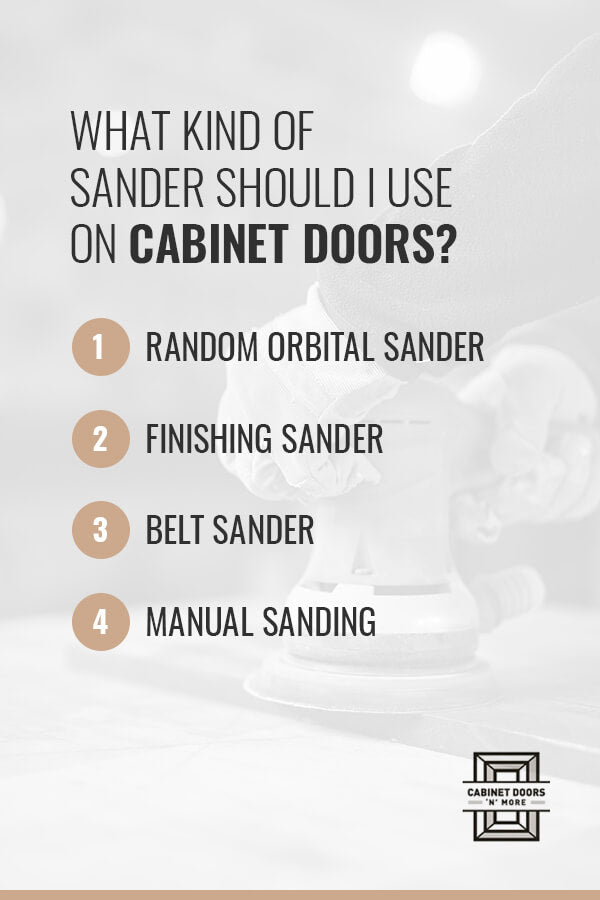
WHAT KIND OF SANDER SHOULD I USE ON CABINET DOORS?
Read more : Leone’s After Kitchen Nightmares – 2023 Update
There are many different types of sanders, but for cabinet doors, you’re most likely looking at one of these options:
- Random orbital sander:The random orbital sander is one of the most popular and versatile sanders. They offer the perfect middle ground between more aggressive sanders and refined finishing sanders. Random orbital sanders feature a disc, usually 5 inches in diameter, that oscillates in a random, unpredictable motion. These movements prevent scratch marks and keep your surface looking smooth. You can buy this kind of sander in wired and wireless versions. If you don’t have any special sanding needs, go with the random orbital sander.
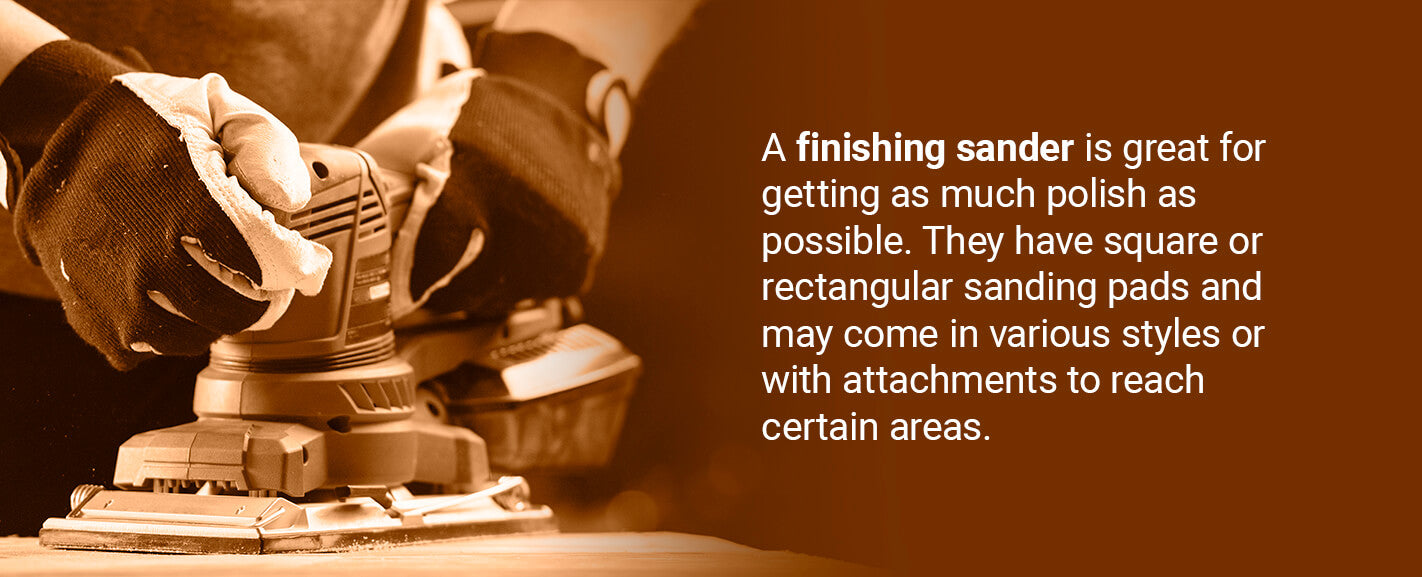
- Finishing sander:A finishing sander is great for getting as much polish as possible. They have square or rectangular sanding pads and may come in various styles or with attachments to reach certain areas. Many finishing sanders can switch between orbital and straight-line sanding. Some people worry that on the last pass, orbital sanding leaves cross-grain scratches. While a light touch and fine grit generally avoid this issue, a finishing sander can offer more control and smoothness over the process.
- Belt sander:If your cabinet doors have a lot of buildup or nicks to smooth out, a belt sander is a more aggressive option. It features a long, rectangular sanding surface from a belt of sandpaper that continuously loops through the machinery. They work best on large, flat areas and can remove more layers than other options, so only use it where heavier removal is needed.
- Manual sanding: While you could manually sand your cabinets entirely, it’s more common to hand sand a few finishing touches or hard-to-reach areas. Flat sanding blocks can cover large areas, such as a final, more delicate pass over the cabinet. For getting into nooks and crannies, you can also get sanding blocks in curved shapes, use the sanding paper as-is, or use a sanding sponge. You can also use steel wool or a scouring pad from the kitchen to get into grooves.
If you’re not using a random orbital sander, move with the grain when sanding. Scratches moving across the grain can stand out, especially after finishing.
WHAT KIND OF FINISH SHOULD I USE AFTER SANDING?
There are many different types of finishes available to help you create the ideal aesthetic for your cabinets and your space. From reflectivity to moisture resistance to how it shows the grain, your finish can play a big role in the look of your new cabinet doors. Here are some of the most popular options:
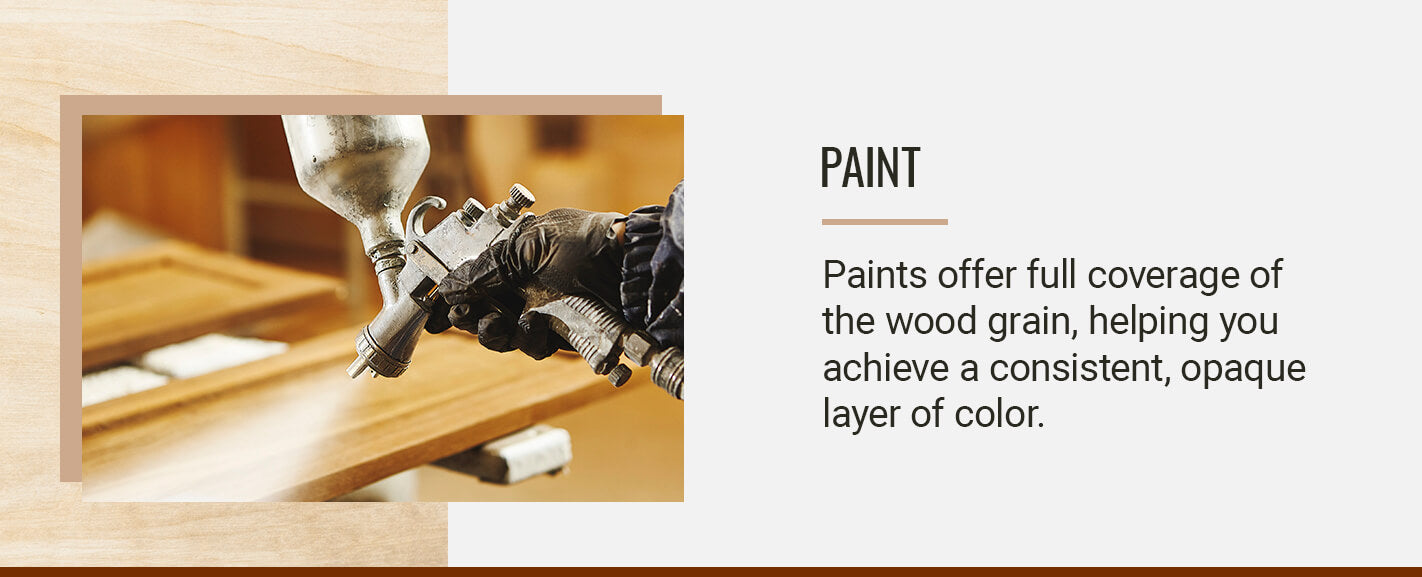
- Paint: If your cabinets are simply the base for a different look, paint is your best bet. Paints offer full coverage of the wood grain, helping you achieve a consistent, opaque layer of color. They come in many different styles and finishes, so you can find the perfect fit for your room and its demands. Paint completely covers the wood grain, unlike these next few finishes that always fall back on the wood’s natural appearance.
- Stain:A stain puts the gorgeous grain of the wood on display, giving it a specific tone and a slight protective layer. Stains can be oil-based, oil-and-varnish-based or water-based. Tinted stains allow you to tweak the color of the wood without covering up the grain with paint.
- Topcoats:Topcoats add a sleek shine to your cabinets. These include varnishes, polyurethane, lacquer and shellac. Topcoats are usually thicker, offering strong protection from nicks and scratches.
- Thermofoil:Thermofoil is a type of vinyl laminate that offers a smooth, non-porous surface. You won’t be able to apply thermofoil yourself, but you can request it from your supplier.
Whatever finish you use, be sure to test it before applying. Stains and topcoats can vary in appearance on different surfaces. If you have a scrap piece of wood or a sample, use that. Otherwise, you can put it in an inconspicuous spot, such as the top edge or the back of the door.
Another way to make things easier when finishing your cabinet doors is to use plastic painter’s pyramids. With a pyramid on each corner, your cabinet door lifts up off the work surface, so you can cover the whole door without uneven coverage or paint pooling at the edges. The pyramids also allow you to keep the door lifted, so you can paint both sides without waiting for one to dry.
HOW SHOULD I APPLY MY FINISH?
You also have a few options for applying your finish, including rolling, brushing and spraying.
Some finishes, like paints, do well with rollers that can cover lots of space with thin, uniform coats. However, rollers aren’t good for getting the details. If your cabinet door isn’t perfectly flat, you’ll likely need a brush to get into the nooks and crannies. Brushes are good for detail work and making thicker layers at once. Depending on your handiwork and the medium, brushing can also offer more visible paint strokes or smoother coverage. If you’re going for a more rustic look, you may opt for this kind of style.
Be sure to match your brush to the medium. Use a natural-bristle brush for an oil-based polyurethane finish and a synthetic brush for a water-based formula.
You can also spray your finish on. Airless sprayers are fast and can help you get a stroke-free finish in one coat. Still, you’ll need to have the right equipment, which is more expensive than a brush or roller, along with clean-up supplies and a wind-free day. Spraying also uses more paint, and beginners might get uneven results.

MAKE THE JOB EASIER WITH CABINET DOORS ‘N’ MORE
Now that you know how to sand wood smooth and apply a perfect finish, you can use this satisfying project to personalize your cabinets to exactly what you’re looking for. If you prefer a simpler approach, you can also eliminate some of the prep work by using cabinet doors that are already sanded or sanded and primed. Here at Cabinet Doors ‘N’ More, we carry a wide range of these ready-to-finish cabinet doors in popular styles like raisedand recessed panels, mullionand Shaker. White primer is available for solid hard maple and MDF cabinet doors and drawer fronts.
With high-quality materials, free shipping and a user-friendly buying experience, you can update your entire kitchen without a complicated process. Explore our products online, or reach out to us with any questions.
Learn More About Cabinet Cleaning & Care
- Cleaning and Care for Finished Cabinetry
- Color Changes in Wood Over Time
- How to Refresh Your Kitchen Cabinets
Source: https://gardencourte.com
Categories: Kitchens


